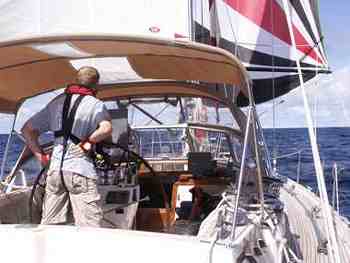Too hot to handle
Hans E512/18/2009, 227 nautical miles East of Barbados
Hookahey: a good day for dying! Today it was hot. In the morning I woke up at 6h for my early morning shift. It was dark, the sun rises between 9h and 10h, because we are still on UTC. Through the night there was not much wind and I slept with the cabin hatch wide open. No risk of rain or ocean water coming over the bow. My cabin is in the bow: a nice place, although Ulric doesn't agree with me: in the bow the boat's motions are sensed much stronger than in the starboard/port side cabins, where Peter sleeps, and than sensed in the aft cabin: traditionally the skipper's cabin. And it's true: sometimes it is like sleeping in a rollercoaster. But not last night.
Yesterday there was not much wind also: Ulric and I more or less decided that we should hoist the spi (spinnaker/balloon foresail) today if the wind didn't increase. I never sailed with a spi before. Ulric has, but not with much success: his spi is new because he broke the previous one when he tried to fly with it. Peter has sailed on a boat with a spi (Queen's Ransom II) some four years ago. None of us has much experience sailing with a spi. Spi-flying is only possible with low wind and bares a great danger of gear-damage. Rewarding is the few extra knots and the increased boat stability: the spi pulls the bow out of the water and prevents the boat from strong rolling.
To hoist the spi we had to remove some of the gear: the genoa had to be furled in, the stay-sail taken away, and the inner stay (where the stay-sail is mounted) had to be removed. Ulric read the procedure in a Sailing Manual so that we would not make mistakes when hoisting the spi. It took us 1 1/2 hour to manage to hoist the spi: connecting starboard and port sheet to the clews of the spi, remove stay-sail and inner stay, furl in genoa, mount the boom for the spi, hoisting the sock and removing the sock so that the spi could unfold itself. Then we spent half an hour to trim the boat. But Ulric wasn't sure if the spi would hold: due to the waves the boat moved too much. Even with low wind the ocean waves are pretty high. The spi caught wind from the wrong side from time to time, whichis dangerous: the fabric of the spi is very light, similar to parachute silk. It can rupture very easily. With his last experience of destroying a spi Ulric didn't want to take the risk again: after one hour trying tostabilise the sail we took it down again. Today it was too hot to handle the spinnaker.
An exciting experience, though! Flying with the wind.
We sailed into the region north of Surinam, a former Dutch colony. We traded it in the past for the island of Manhattan with the British. Manhattan became (as a part of the US) independent 200 years earlier than Surinam, which is an independent country since 1975. Capital is Paramaribo ("Parbo"). Its size of 165 000 squared kilometers (rough guess) is about 4 times that of the Netherlands. There live perhaps 300 000 - 400 000 inhabitants. After a long time of dictatorship under Desi Bouterse things have become more normal in the last decade. At least four of the Dutch crews we met in the Cape Verdes aimed at Surinam as an intermediate stop for the Caribbean. We are about 400 NM of Surinam's (North) Coast sailing almost straight westwards to Barbados, island of palmtrees, white beaches and rum-cocktails. And flying fish sandwiches! I knew you could eat flying fish but have read on the internet that they didn't taste very well. Apparently this must be a myth because it is the typical Bajan snack.
Watching Queenie's wake while sitting at her swim-platform is
one of my favorite and relaxing wastes of time ... (Hans)
avi-films:


At sunset we set the inner stay and stay-sail again, just before dinner: cous cous with dried apricots, feta, dried tomatoes, chicken stock. We drink some beer and wine: San Miguel (spanish lager beer), Guinness (stout). and white wine; some spanish mainland wine. After dinner music of the Waterboys with coffee and dark chocolate: 85 % cocoa; in this temperature even this chocolate is soft. In the early night we gybe the mainsail to port to maintain an optimal course to Barbados.
Current arrival estimates, based on present speed of 5 knots over ground: 20 Dec 08h UTC. Local Barbados time this is 4h in the morning. I am on my dogwatch when I write this, likely my last dogwatch on QRIII. I hope to spent my next dogwatch in some Bridgetown bar.
| \/ | \/ |

